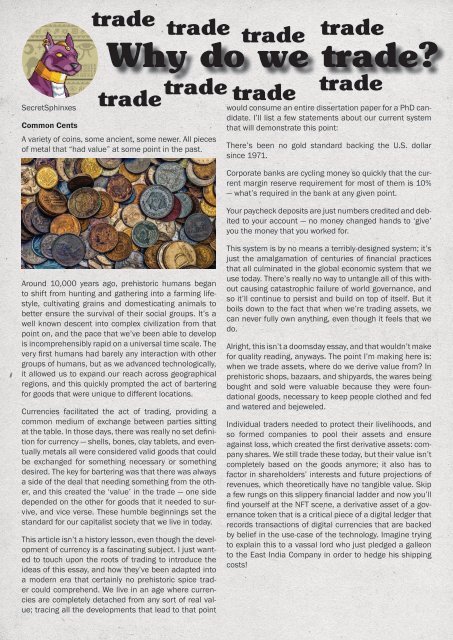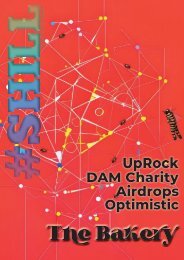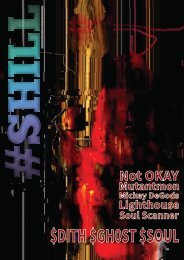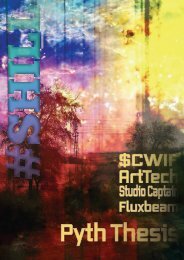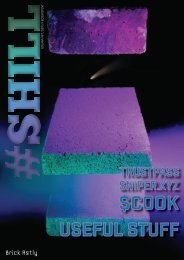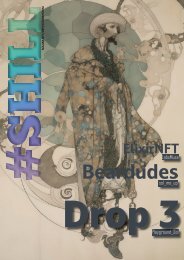Create successful ePaper yourself
Turn your PDF publications into a flip-book with our unique Google optimized e-Paper software.
trade trade<br />
trade<br />
trade<br />
SecretSphinxes<br />
Common Cents<br />
trade trade trade<br />
A variety of coins, some ancient, some newer. All pieces<br />
of metal that “had value” at some point in the past.<br />
trade<br />
would consume an entire dissertation paper for a PhD candidate.<br />
I’ll list a few statements about our current system<br />
that will demonstrate this point:<br />
There’s been no gold standard backing the U.S. dollar<br />
since 1971.<br />
Corporate banks are cycling money so quickly that the current<br />
margin reserve requirement for most of them is 10%<br />
— what’s required in the bank at any given point.<br />
Your paycheck deposits are just numbers credited and debited<br />
to your account — no money changed hands to ‘give’<br />
you the money that you worked for.<br />
Around 10,000 years ago, prehistoric humans began<br />
to shift from hunting and gathering into a farming lifestyle,<br />
cultivating grains and domesticating animals to<br />
better ensure the survival of their social groups. It’s a<br />
well known descent into complex civilization from that<br />
point on, and the pace that we’ve been able to develop<br />
is incomprehensibly rapid on a universal time scale. The<br />
very first humans had barely any interaction with other<br />
groups of humans, but as we advanced technologically,<br />
it allowed us to expand our reach across geographical<br />
regions, and this quickly prompted the act of bartering<br />
for goods that were unique to different locations.<br />
Currencies facilitated the act of trading, providing a<br />
common medium of exchange between parties sitting<br />
at the table. In those days, there was really no set definition<br />
for currency — shells, bones, clay tablets, and eventually<br />
metals all were considered valid goods that could<br />
be exchanged for something necessary or something<br />
desired. The key for bartering was that there was always<br />
a side of the deal that needing something from the other,<br />
and this created the ‘value’ in the trade — one side<br />
depended on the other for goods that it needed to survive,<br />
and vice verse. These humble beginnings set the<br />
standard for our capitalist society that we live in today.<br />
This article isn’t a history lesson, even though the development<br />
of currency is a fascinating subject. I just wanted<br />
to touch upon the roots of trading to introduce the<br />
ideas of this essay, and how they’ve been adapted into<br />
a modern era that certainly no prehistoric spice trader<br />
could comprehend. We live in an age where currencies<br />
are completely detached from any sort of real value;<br />
tracing all the developments that lead to that point<br />
This system is by no means a terribly-designed system; it’s<br />
just the amalgamation of centuries of financial practices<br />
that all culminated in the global economic system that we<br />
use today. There’s really no way to untangle all of this without<br />
causing catastrophic failure of world governance, and<br />
so it’ll continue to persist and build on top of itself. But it<br />
boils down to the fact that when we’re trading assets, we<br />
can never fully own anything, even though it feels that we<br />
do.<br />
Alright, this isn’t a doomsday essay, and that wouldn’t make<br />
for quality reading, anyways. The point I’m making here is:<br />
when we trade assets, where do we derive value from? In<br />
prehistoric shops, bazaars, and shipyards, the wares being<br />
bought and sold were valuable because they were foundational<br />
goods, necessary to keep people clothed and fed<br />
and watered and bejeweled.<br />
Individual traders needed to protect their livelihoods, and<br />
so formed companies to pool their assets and ensure<br />
against loss, which created the first derivative assets: company<br />
shares. We still trade these today, but their value isn’t<br />
completely based on the goods anymore; it also has to<br />
factor in shareholders’ interests and future projections of<br />
revenues, which theoretically have no tangible value. Skip<br />
a few rungs on this slippery financial ladder and now you’ll<br />
find yourself at the NFT scene, a derivative asset of a governance<br />
token that is a critical piece of a digital ledger that<br />
records transactions of digital currencies that are backed<br />
by belief in the use-case of the technology. Imagine trying<br />
to explain this to a vassal lord who just pledged a galleon<br />
to the East India Company in order to hedge his shipping<br />
costs!


